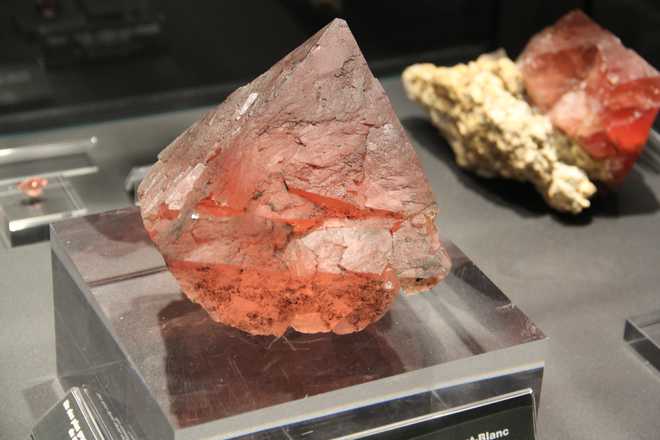
The crystal hunters sold the crystals to watch and chandelier makers in Geneva and Milan. Photos by the writer
Kalpana Sunder
Cluster of rose pink fluorite crystals, striated crystalsin a vibrant red color…Smoky quartz, which forms in bands in the granite walls of the Alps. Imagine grabbing ropes, pickaxes, and camping gear and ascending into the clouds and treacherous terrain where avalanches and landslides are common, to find glittering treasures — huge glittering rocks… This is what a crystal hunter does. It was crystal hunter Jacques Balmat, who claimed the historic first ascent of Mont Blanc with Dr Michel-Gabriel Paccard on August 8, 1786. And it was their success that established Chamonix as the birthplace of modern mountaineering.
Chamonix, a town of about 10,000 people, sits in an ancient glacial valley an hour’s drive south of Geneva, Switzerland. The town showcases some of Europe’s most spectacular topography — Granite ridges that loom like monsters above cobblestone streets and glaciers that flow down the flanks of mountains like silvery gowns. Crystal hunters of yore were tenacious and brave people who battled ice storms and avalanches on the high mountains in the hope of finding a precious crystal. “The crystal hunters have been scaling mountains long before climbing existed as a sport. But the idea of finding a treasure was their motive for setting out on their adventures,” explains guide Cecile Truffat, from the local tourism board.
Quartz, the most versatile of any of the gem families, is found in nature as crystals that are often twinned, or fused with adjacent crystals of quartz or other minerals. Quartz offers a variety of colour choices in both transparent and non-transparent varieties. Of the transparent types of quartz, amethyst is the most valuable one... Yellowish shades of quartz are called citrine and brownish quartz is called smoky topaz. Rose quartz is a light to dark pink variety, which was popular for many years in carved pieces such as beads, statues, and brooches.
Since the middle ages, local inhabitants of Chamonix Mont- Blanc, who lead lives as hardy farmers, have searched for these crystals to sell these to watch manufacturers and chandelier makers in Geneva and Milan. The Alps harbor beautiful crystals in the Mont Blanc area. Most of the minerals found here are of quartz and also the smoky fluorite.
The Musee de Cristaux (Crystal Museum) in Chamonix Mont- Blanc houses more than 500 specimens from the Mont Blanc massif, as well as from around the world. The beautiful collection has some of the best finds since the Victorian times. It is housed in the same building as the Exposition Alpinism with explanations of how it was “crystal hunting” that first brought wealth to Chamonix and how Mont Blanc and the Alps were formed.
There is a permanent exhibition of the crystal collections of the Mineralogy Club of Chamonix. Occupying centrestage is a massive pink fluorite crystal-3,7kg and 19 cm found in Chamonix. The museum explains how these crystals are formed, how quartz is used everyday in our lives — in watches, TVs, etc. There’s a large showcase in the centre of the hall in the form of a wave, which show 40 specimens from various regions of the world — elements coming from other continents like the Himalayas, Urals and Namibia, which are aesthetically amazing.
Crystal hunting has been a mountain tradition since centuries. “The crystal hunter is a unique breed and multifaceted — he is a climber, geologist, mineralogist and collector,” explains our local guide. Laws prohibit the use of dynamite, machines or heavy equipment to remove the rocks. You can only remove as much crystal as you can carry without using transport.
The harvest begins when the crystal hunters find a suitable cave — Known as crystal-ovens, these provide the ideal setting for the geological processes that allow crystals to grow. They usually find seams and mirrors of quartz, but if they are very lucky they find malachite and shiny fluorites.
Despite its dangers, crystal-hunting has been a hobby for more than two centuries; treasures make the danger and discomfort of the Alps worthwhile!
Chamonix’s mineralogy club has its own code of honour for prospective thrill seekers. Today there are only around 20 intrepid crystal hunters in Chamonix, who still perform this ancestral activity; while tourists ski, they diligently take their ropes and picks and climb the towering mountains in search of these glittering treasures.



























